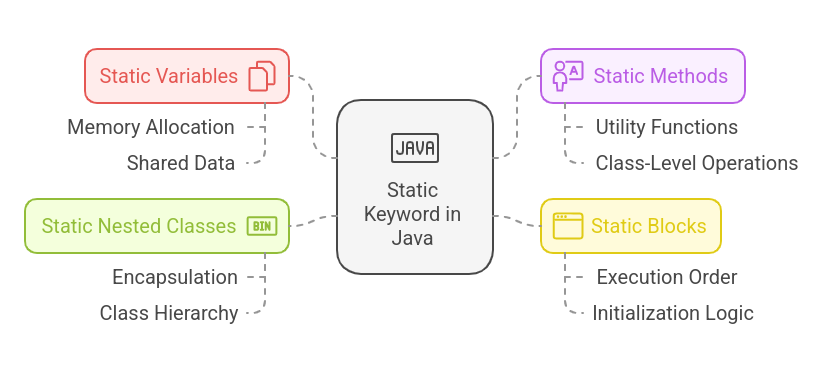- Introduction to the StringBuilder class and its benefits
- Understanding the StringBuilder Class
- Differences between StringBuilder and String classes
- Advantages of using StringBuilder for efficient string manipulation
- Java StringBuilder Examples
- StringBuilder Methods for String Manipulation
- Performance Benefits of StringBuilder
- Benchmarking and comparison of StringBuilder with string concatenation
- Best Practices for Using StringBuilder
- StringBuilder vs StringBuffer
- StringBuilder and Immutability
- Use cases where StringBuilder is preferable to immutable strings
- StringBuilder and Memory Efficiency
- Strategies for managing memory with StringBuilder
- Conclusion
String manipulation is a fundamental aspect of Java programming, as it allows developers to process and modify textual data. In Java, strings are immutable, meaning they cannot be changed once created. While immutability ensures the integrity of data, it can be inefficient and memory-consuming when performing frequent string concatenation or modification operations. This is where the StringBuilder class comes into play.
String manipulation is crucial in various programming tasks, such as data processing, text parsing, and generating dynamic content. It involves operations like concatenating, inserting, deleting, replacing, and reversing strings. Efficient string manipulation is essential for enhancing code performance and improving the overall user experience.
Learn Java the right way! Our course teaches you essential programming skills, from coding basics to complex projects, setting you up for success in the tech industry.
Introduction to the StringBuilder class and its benefits
The StringBuilder class in Java provides a more efficient and flexible way to manipulate strings compared to the traditional string concatenation approach. StringBuilder is part of the Java.lang package and offers a mutable sequence of characters. It allows for dynamic modification of strings without creating new instances, resulting in enhanced performance and reduced memory overhead. The StringBuilder class provides a set of methods that enable efficient string manipulation, making it a valuable tool for developers seeking optimal performance in their Java applications.
Understanding the StringBuilder Class
String manipulation is a fundamental aspect of Java programming, and efficient string handling is essential for optimal performance. By understanding the StringBuilder class and its benefits, developers can enhance the performance of their Java applications and improve the overall user experience.
- Definition and purpose of StringBuilder in Java
The StringBuilder class is a part of the Java.lang package and is designed for efficient string manipulation. It represents a mutable sequence of characters, allowing developers to modify strings dynamically. The primary purpose of StringBuilder is to efficiently build and manipulate strings by appending, inserting, deleting, or replacing characters. Unlike the String class, which is immutable and requires the creation of new instances for each modification, StringBuilder provides a more efficient approach to handling string manipulation tasks.
Differences between StringBuilder and String classes
One key difference between StringBuilder and the String class is mutability. While strings created with the String class are immutable, meaning they cannot be changed once created, StringBuilder provides a mutable sequence of characters that can be modified as needed. This mutability allows StringBuilder to be more efficient in scenarios where frequent string modifications are required, as it avoids unnecessary memory allocations and object creations.
Another difference lies in the methods available for string manipulation. StringBuilder offers a set of methods specifically designed for appending, inserting, deleting, and replacing characters in a string. These methods provide efficient ways to modify strings without the need for additional memory allocations or object creations.
Advantages of using StringBuilder for efficient string manipulation
Using StringBuilder offers several advantages for efficient string manipulation in Java. StringBuilder allows for in-place modification of strings, eliminating the need for creating new string objects for each modification. This leads to improved memory utilization and reduced overhead.
StringBuilder provides better performance compared to traditional string concatenation using the "+" operator. When concatenating multiple strings using the "+" operator, new string objects are created for each concatenation, resulting in unnecessary memory allocations and object creations. StringBuilder, on the other hand, avoids these overheads by efficiently managing the underlying character array and minimizing memory allocations.
StringBuilder offers flexibility and convenience with its comprehensive set of methods for string manipulation. Developers can easily append, insert, delete, or replace characters within a string using the provided methods, making complex string operations more straightforward and efficient.
Java StringBuilder Examples
- Appending Strings
StringBuilder sb = new StringBuilder();
sb.append("Hello");
sb.append(" ");
sb.append("World!");
String result = sb.toString();
System.out.println(result); // Output: Hello World!
- Inserting String
StringBuilder sb = new StringBuilder("Hello!");
sb.insert(5, " World");
String result = sb.toString();
System.out.println(result); // Output: Hello World!
- Deleting Characters
StringBuilder sb = new StringBuilder("Hello World!");
sb.delete(6, 11);
String result = sb.toString();
System.out.println(result); // Output: Hello!
- Reversing a String
StringBuilder sb = new StringBuilder("Hello");
sb.reverse();
String result = sb.toString();
System.out.println(result); // Output: olleH
- Setting the Length of StringBuilder
StringBuilder sb = new StringBuilder("Hello World!");
sb.setLength(5);
String result = sb.toString();
System.out.println(result); // Output: Hello
- Chaining StringBuilder Methods
StringBuilder sb = new StringBuilder();
sb.append("Hello").append(" ").append("World!");
String result = sb.toString();
System.out.println(result); // Output: Hello World!
StringBuilder Methods for String Manipulation
The StringBuilder class provides a wide range of methods that facilitate efficient string manipulation.
- append() method for concatenating strings
The append() method is one of the most commonly used methods in StringBuilder for string concatenation. It allows you to append characters, strings, or other data types to the end of the StringBuilder object. By using append(), you can easily concatenate multiple strings without the need to create new string objects. This method offers flexibility and convenience, making it ideal for building complex strings or dynamically constructing string representations.
- insert() method for inserting text at specific positions
The insert() method enables you to insert characters or strings at specific positions within a StringBuilder object. It takes two parameters: the index at which the insertion should occur and the data to be inserted. This method is particularly useful when you need to insert text at a specific location, such as adding a prefix or inserting values in a specific format. The insert() method allows you to modify the content of the StringBuilder object without recreating the entire string.
- delete() and deleteCharAt() methods for removing characters from a string
The delete() method enables you to remove a range of characters from a StringBuilder object. It takes two parameters: the starting index and the ending index (exclusive) of the range to be deleted. This method provides a convenient way to remove substrings or unwanted characters from a string without the need to create new objects.
In addition to delete(), the deleteCharAt() method allows you to remove a single character at a specified index within the StringBuilder object. This method is useful when you need to remove specific characters or perform selective deletions within a string.
- replace() method for replacing characters or substrings
The replace() method enables you to replace characters or substrings within a StringBuilder object. It takes three parameters: the starting index, the ending index (exclusive) of the range to be replaced, and the replacement string or character. This method offers a powerful way to modify specific portions of a string without reconstructing the entire string. It can be used to replace individual characters, substrings, or even entire sections of text.
- reverse() method for reversing the contents of a StringBuilder
The reverse() method enables you to reverse the order of characters within a StringBuilder object. This can be useful when you need to reverse the content of a string, such as when dealing with palindrome detection or modifying string representations. The reverse() method operates directly on the characters in the StringBuilder object, providing an efficient way to reverse strings without creating new objects.
By leveraging these methods, developers can efficiently manipulate strings using StringBuilder, avoiding unnecessary memory allocations and object creations. These methods provide flexibility and control over string modifications, allowing for efficient concatenation, insertion, deletion, replacement, and reversal operations.
Performance Benefits of StringBuilder
One of the key advantages of using StringBuilder for string manipulation in Java is its enhanced performance compared to traditional string concatenation. Let's delve into the performance benefits offered by StringBuilder and understand why it is the preferred choice for efficient string manipulation.
In Java, strings are immutable, meaning they cannot be modified once created. Whenever string concatenation is performed using the '+' operator or string concatenation methods like concat(), new string objects are created. This can result in unnecessary memory allocations and object creations, especially when concatenating multiple strings in a loop or complex operations.
StringBuilder, on the other hand, provides a mutable sequence of characters, allowing for efficient modification without creating new string objects. StringBuilder achieves this by internally managing a resizable array that can be modified as needed. This eliminates excessive memory allocations and object creation, resulting in improved performance and reduced memory overhead.
Benchmarking and comparison of StringBuilder with string concatenation
To validate the performance benefits of StringBuilder, let's compare it with traditional string concatenation using benchmarking. You can measure the execution time and memory usage of both approaches to gain insights into their relative performance.
In a benchmark test, you can perform string concatenation using string concatenation operators or methods, and measure the time taken and memory used. You can then repeat the same test using StringBuilder and compare the results. The benchmarking process will demonstrate the superior performance of StringBuilder, especially when dealing with large strings or repetitive concatenations.
Let's consider an example where you need to concatenate a large number of strings, such as generating a CSV file with thousands of rows. Using traditional string concatenation, each concatenation operation creates a new string object, resulting in significant memory overhead and slower execution time.
By employing StringBuilder, you can optimize the concatenation process. You can append each row of data to the StringBuilder object, eliminating the need for creating intermediate string objects. This approach drastically reduces memory usage and improves performance, as StringBuilder efficiently manages the character sequence and avoids unnecessary memory allocations.
By showcasing such examples and conducting performance comparisons, developers can witness the significant performance benefits offered by StringBuilder. This knowledge empowers developers to make informed decisions and choose the most efficient approach for string manipulation, leading to improved application performance and reduced resource consumption.
Best Practices for Using StringBuilder
To leverage the full potential of StringBuilder and ensure efficient and effective string manipulation in Java, it is important to follow certain best practices.
- Guidelines for efficient and effective use of StringBuilder
- Initialize StringBuilder with an appropriate initial capacity: When creating a StringBuilder object, it is advisable to estimate the expected size of the final string and initialize it with an initial capacity. This can prevent unnecessary resizing of the internal character array, improving performance.
- Use append() for concatenation: The append() method is the primary tool for concatenating strings using StringBuilder. It allows you to efficiently add characters, strings, or other data types to the StringBuilder object.
- Minimize unnecessary method calls: To optimize performance, avoid unnecessary method calls on the StringBuilder object. Only call methods like append(), insert(), or delete() when needed to minimize unnecessary operations.
- Tips for optimizing StringBuilder operations
- Use specific append() methods: StringBuilder provides specialized append() methods for different data types, such as append(int), append(double), or append(boolean). Using these specific methods can improve performance by avoiding unnecessary type conversions.
- Avoid unnecessary conversions: When appending data to StringBuilder, avoid unnecessary conversions between data types. For example, if you have an integer value, directly append it using the append(int) method instead of converting it to a string.
- Reuse StringBuilder objects: In scenarios where you need to perform multiple string manipulations, consider reusing the same StringBuilder object. Resetting the length of the StringBuilder using setLength(0) allows you to clear the existing content and reuse the object, reducing memory allocations.
- Handling large strings with StringBuilder efficiently
When dealing with large strings, it is essential to employ strategies to optimize memory usage and performance. Here are some techniques to handle large strings efficiently with StringBuilder:
- Chunked processing: Instead of manipulating the entire large string at once, consider processing it in smaller chunks. This can help reduce memory consumption and improve overall performance.
- Streaming data: If you are processing data streams or reading large files, use StringBuilder in conjunction with buffered reading techniques. Read the data in chunks, append it to the StringBuilder, and process it incrementally, rather than loading the entire data into memory at once.
By following these best practices, developers can ensure efficient and optimized string manipulation using StringBuilder in Java. Adhering to these guidelines, utilizing specific methods, and handling large strings effectively will lead to enhanced performance, reduced memory usage, and improved overall application efficiency.
StringBuilder vs StringBuffer
When it comes to string manipulation in Java, developers often encounter two classes: StringBuilder and StringBuffer. While they serve a similar purpose, there are important differences to consider.
- Comparison between StringBuilder and StringBuffer classes
- Mutability: Both StringBuilder and StringBuffer are mutable classes, allowing efficient modification of strings. They provide methods for appending, inserting, deleting, and replacing characters or substrings.
- Thread-safety: The key distinction between StringBuilder and StringBuffer lies in their thread-safety properties. StringBuilder is not thread-safe, meaning it is not synchronized and not suitable for use in concurrent environments. On the other hand, StringBuffer is thread-safe, ensuring synchronized access to its methods and making it suitable for multi-threaded applications.
- Differences in performance and thread-safety
- Performance: StringBuilder is generally faster than StringBuffer because it does not incur the overhead of synchronization. In single-threaded scenarios, where thread-safety is not a concern, StringBuilder offers better performance due to its non-synchronized nature.
- Thread-safety considerations: If your application requires concurrent access to string manipulation operations, StringBuffer provides the necessary synchronization to ensure thread-safety. This synchronization comes at a performance cost. If thread-safety is not a requirement, StringBuilder is the preferred choice for its enhanced performance.
- Choosing the appropriate class based on the application requirements
- Single-threaded applications: For single-threaded scenarios, where there is no need for synchronization, StringBuilder is the recommended choice. Its efficient string manipulation methods and non-synchronized nature contribute to improved performance.
- Multi-threaded applications: In multi-threaded environments where multiple threads need to manipulate strings concurrently, StringBuffer should be used. Its synchronized methods guarantee thread-safety but introduce a performance trade-off.
It is important to carefully evaluate the requirements of your application when choosing between StringBuilder and StringBuffer. Consider factors such as performance, thread-safety, and the specific needs of your application. By selecting the appropriate class, you can ensure efficient and reliable string manipulation in your Java codebase.
StringBuilder and Immutability
Strings are immutable in Java, meaning they cannot be changed once created. This immutability has important implications for string manipulation, as any modification operation on a string results in creating new string object. While immutability offers benefits such as thread-safety and cacheability, it can also lead to inefficiencies when performing extensive string manipulations. This is where StringBuilder comes into play.
- Immutability concept: In Java, strings are immutable objects, which means their values cannot be modified after they are created. When a modification operation, such as concatenation or replacement, is performed on a string, a modified value is assigned to a new string object, while the original string remains unchanged.
- Benefits of immutability: String immutability ensures thread-safety, as strings can be safely shared among multiple threads without the risk of concurrent modifications. Immutability also allows strings to be cached and used as keys in hash-based data structures like HashMap.
How does StringBuilder helps overcome the limitations of string immutability?
Mutable nature of StringBuilder: StringBuilder is a mutable class in Java that allows efficient string manipulation. Unlike strings, StringBuilder objects can be modified in-place, avoiding the need for creating new string objects for each modification.
Building strings incrementally: StringBuilder provides methods like append(), insert(), delete(), and replace() to modify the contents of the string it holds. These operations directly modify the internal buffer of the StringBuilder, leading to efficient string manipulation without creating unnecessary string objects.
Use cases where StringBuilder is preferable to immutable strings
Dynamic string building: StringBuilder offers significant performance advantages over immutable strings when you need to build a string incrementally, such as concatenating multiple strings or appending characters in a loop. It avoids the overhead of creating intermediate string objects, resulting in faster and more efficient code execution.
String manipulation with large data: If you are working with large strings or performing extensive string manipulation operations, StringBuilder can greatly improve performance by reducing memory consumption and garbage collection overhead.
In scenarios where string immutability is not a requirement and efficient string manipulation is essential, StringBuilder is the preferred choice. Its mutable nature allows for in-place modifications, enhancing performance and reducing memory overhead. By leveraging the capabilities of StringBuilder, you can streamline your string manipulation tasks and improve your Java applications' efficiency.
StringBuilder and Memory Efficiency
In addition to offering enhanced performance for string manipulation, StringBuilder also provides advantages in terms of memory efficiency. Understanding the memory usage of StringBuilder and employing strategies to manage memory effectively can further optimize your code.
Dynamic resizing: StringBuilder manages an internal buffer that holds the characters of the string being manipulated. Initially, the buffer has a default capacity, but it automatically resizes itself when necessary to accommodate larger strings. This dynamic resizing ensures efficient memory allocation and utilization.
Capacity and length: The capacity of a StringBuilder represents the total number of characters it can currently hold without resizing. The length, on the other hand, indicates the number of characters present in the StringBuilder. By default, the capacity of a StringBuilder is set to 16, but you can explicitly set it using the constructor to optimize memory usage.
Strategies for managing memory with StringBuilder
- Set initial capacity: If you have an estimate of the final string length, setting the initial capacity of the StringBuilder can prevent unnecessary resizing operations. By providing an appropriate capacity, you allocate sufficient memory upfront, avoiding frequent reallocation and improving memory efficiency.
- Use trimToSize(): The trimToSize() method allows you to release any unused memory in the internal buffer of the StringBuilder. After performing string manipulation operations, calling this method trims the buffer's capacity to match the current length, reducing memory overhead.
- Reuse StringBuilder instances: Instead of creating a new StringBuilder for each string manipulation task, consider reusing existing instances. Resetting the length of the StringBuilder using setLength(0) allows you to clear the contents and reuse it for subsequent operations, reducing memory allocations.
- Use delete() instead of creating a new StringBuilder: When removing a portion of the string, consider using the delete() method to modify the existing StringBuilder rather than creating a new StringBuilder with the desired portion. This approach avoids unnecessary memory allocations and improves memory efficiency.
By employing these memory management strategies, you can optimize the memory usage of StringBuilder and ensure efficient string manipulation in your Java applications. Understanding the internals of StringBuilder and making informed decisions regarding capacity and memory utilization will contribute to the overall performance and resource efficiency of your code.
By adopting these best practices and understanding the memory efficiency of StringBuilder, you can optimize your string manipulation tasks and achieve enhanced performance in your Java applications. Efficient string operations are crucial for improving the overall performance and responsiveness of your code.
Take a look at the Advanced Certificate Program in Full Stack Software Development – your gateway to an exhilarating career. Whether you're a novice or aiming to enhance your expertise, this program provides you with the essential tools for achieving success.
Conclusion
StringBuilder is a valuable tool for Java developers seeking efficient and performant string manipulation. Its ability to dynamically manage a mutable sequence of characters, along with its flexible methods, makes it an essential class for optimizing string operations. By leveraging StringBuilder effectively and following the best practices outlined in this article, you can streamline your code and enhance the performance of your Java applications.
Keep in mind the importance of optimizing string operations and continually seeking ways to improve performance in your Java applications. With StringBuilder as a powerful tool in your toolkit, you are well-equipped to tackle complex string manipulation tasks and deliver efficient, high-performance code.
Explore a selection of software development courses curated to kickstart your journey in this dynamic field. These comprehensive courses are meticulously crafted to impart the fundamental skills demanded by the industry. Embark on your path towards a thriving software development career right now!






